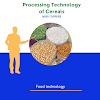RICE BRAN: INTRODUCTION, COMPOSITION, USES,
STABILIZATION AND ITS METHODS
INTRODUCTION
Rice husk and rice bran (Fig 10.1) are the two main by-products of rice milling industry.Commercially rice bran is the most valuable by-product. It is obtained from the brown rice.
Generally, rice bran consists of pericarp, aleurone layer, germ, and a part of endosperm. (Fig 10.2)Bran removal amounts to 4–9% of the total weight of the paddy milled however, true bran amounts to 4-5 % only, rest is polish consisting of inner bran layers and portion of the starchy endosperm. Rice bran is a valuable source of edible oil and protein- rich animal feed.
Structure of rice grain showing the bran
COMPSITION
Rice bran is the outer layer of the rice grain It contains most of the nutrients: carbohydrates (40–50%), lipids (15–20%), protein (12–15%), crude fibre (7–11%) and ash (6–9%).It also contains vitamins and many other useful chemicals. In particular, rice lipids and bioactive components are concentrated in rice bran. Fatty acids such as palmitate (21–26%), linoleate (31–33%) and oleate (37–42%) are predominant in rice bran. In addition, due to its high content of polyunsaturated fatty acids, rice bran is considered a healthy food. Significant quantities of bioactive compounds such as γ‐oryzanol, tocotrienol, tocopherol and α‐sitosterol as well as dietary fibres such as α‐glucan, pectin and gum have been found in rice bran . Specifically, γ‐oryzanol, the main antioxidant present in rice bran, has a 10‐times higher antioxidant activity than tocopherol, while tocotrienol has 40–60 times greater antioxidant activity than tocopherol.
However, the proportions of these phytochemicals vary with the type of rice cultivar. In addition, rice bran contains 4‐hydroxy‐3‐methoxycinnamic acid (FA), which has photoprotective and antioxidative effects.
USES OF RICE BRAN
Rice bran can be utilized in several ways
It is potential source of vegetable oil. Edible grade oil is produced by refining crude bran
oil
It is useful as feed for poultry and other livestock because of its nutritive value.
Most stable defatted bran containing high percentage of protein, vitamins and minerals is an excellent ingredient for both food and feed.
Crude bran oil of high EFA content is used for the manufacture of soap and fatty acids.
Bran is often used to enrich breads (notably muffins) and breakfast cereals, especially for the benefit of those wishing to increase their intake of dietary fibre.
Bran may also be used for pickling (nukazuke) as in the tsukemono of Japan.
Bran oil may be also extracted for use by itself for industrial purposes (such as in the
paint industry).
It contains a number of nutrients and biologically active compounds The identification of the bioactive components contained in rice bran has reinforced its status as a functional food. Experiments have revealed that enzyme‐treated or ethanol‐extracted rice bran (6% of the diet for 8 weeks) improves blood pressure (BP), the lipid profile and glucose metabolism. Furthermore, adenosine supplementation (10 mg/kg body weight), an active component of functional bran, improved metabolic syndrome in stroke‐prone spontaneously hypertensive rats. In addition, ferulic acid (FA) supplementation (9.5 mg/kg body weight), another active compound in functional bran (0.19 mg/100 g of rice bran), improves BP and the lipid profile.
STABILIZATION OF RICE BRAN
Heat generated during milling triggers enzymatic activity, resulting in the hydrolysis of lipid, and oxidative changes leading to rancidity. Hence, the bran must be stabilized as quickly as possible after production to prevent the rancidity.
It is common practice to heat-treat bran with the intention of slowing undesirable rancidification. However, a very detailed 2003 study of heat-treatment of oat bran found a complex pattern whereby increasingly intense heat treatment reduced the development of hydrolytic rancidity and bitterness with time, but increased oxidative rancidity. It is therefore recommended that heat treatment should be sufficient to achieve selective lipase inactivation, but not so much as to render the polar lipids oxidizable upon prolonged storageS Stabilizationof rice bran can be achieved by dielectric heating, treatment with hydrochloric acid and treatment with sodium metabisulfite. Recently, extrusion-cooking process has proved very successful and cheaper. Rice bran oil is extracted with light petroleum spirit (n – hexane); the process is thus hazardous.
A new simple chemical method for stabilization of rice bran is described. The process, based on the principle that lipase activity will be low at low pH, uses hydrochloric acid at 40 l/ton of bran for lowering the pH of rice bran from 6.9–6.0 to 4.0. The acid can be applied easily by sprinkling or spraying.
Processing of Rice Bran Oil
The flow diagram for extraction of rice bran oil is depicted in Figure 8.2. An asterisk in the Figure indicates that the products are of value e.g. for soap Manufacturing, etc.

















0 Comments
Send feedback